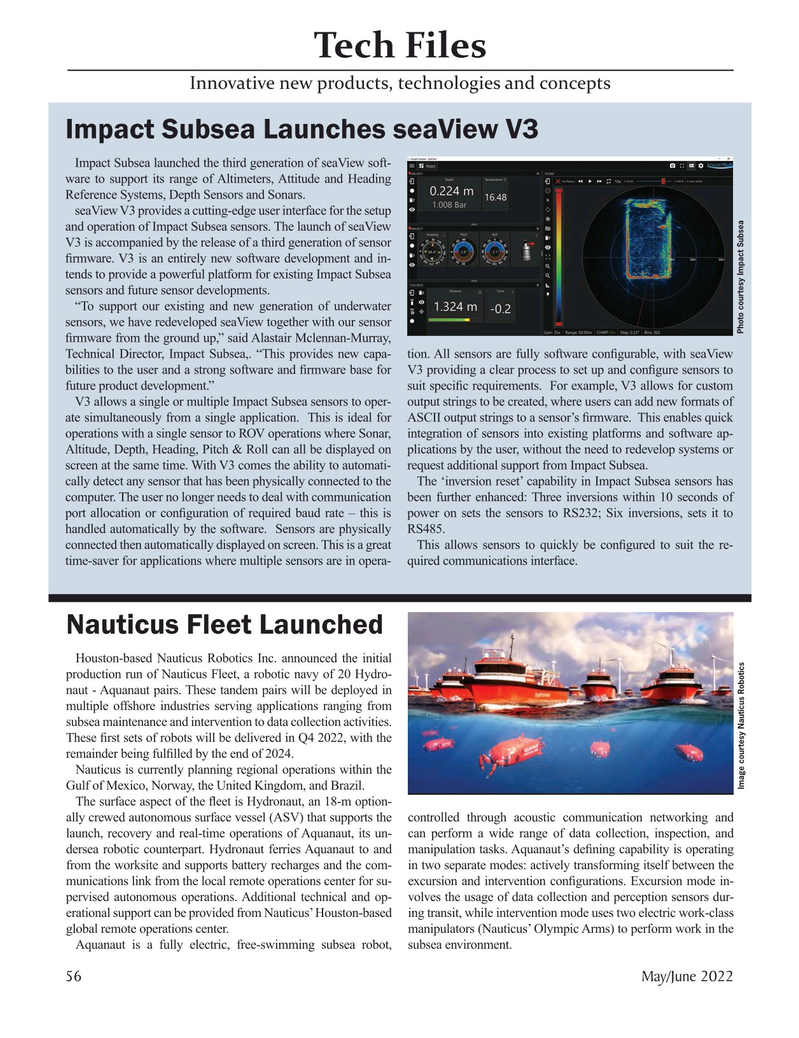
Page 56: of Marine Technology Magazine (May 2022)
Read this page in Pdf, Flash or Html5 edition of May 2022 Marine Technology Magazine
Tech Files
Innovative new products, technologies and concepts
Impact Subsea Launches seaView V3
Impact Subsea launched the third generation of seaView soft- ware to support its range of Altimeters, Attitude and Heading
Reference Systems, Depth Sensors and Sonars.
seaView V3 provides a cutting-edge user interface for the setup and operation of Impact Subsea sensors. The launch of seaView
V3 is accompanied by the release of a third generation of sensor ? rmware. V3 is an entirely new software development and in- tends to provide a powerful platform for existing Impact Subsea sensors and future sensor developments. “To support our existing and new generation of underwater sensors, we have redeveloped seaView together with our sensor ? rmware from the ground up,” said Alastair Mclennan-Murray,
Technical Director, Impact Subsea,. “This provides new capa- tion. All sensors are fully software con? gurable, with seaView bilities to the user and a strong software and ? rmware base for V3 providing a clear process to set up and con? gure sensors to future product development.” suit speci? c requirements. For example, V3 allows for custom
V3 allows a single or multiple Impact Subsea sensors to oper- output strings to be created, where users can add new formats of ate simultaneously from a single application. This is ideal for ASCII output strings to a sensor’s ? rmware. This enables quick operations with a single sensor to ROV operations where Sonar, integration of sensors into existing platforms and software ap-
Altitude, Depth, Heading, Pitch & Roll can all be displayed on plications by the user, without the need to redevelop systems or screen at the same time. With V3 comes the ability to automati- request additional support from Impact Subsea. cally detect any sensor that has been physically connected to the The ‘inversion reset’ capability in Impact Subsea sensors has computer. The user no longer needs to deal with communication been further enhanced: Three inversions within 10 seconds of port allocation or con? guration of required baud rate – this is power on sets the sensors to RS232; Six inversions, sets it to handled automatically by the software. Sensors are physically RS485. connected then automatically displayed on screen. This is a great This allows sensors to quickly be con? gured to suit the re- time-saver for applications where multiple sensors are in opera- quired communications interface.
Nauticus Fleet Launched
Houston-based Nauticus Robotics Inc. announced the initial production run of Nauticus Fleet, a robotic navy of 20 Hydro- naut - Aquanaut pairs. These tandem pairs will be deployed in multiple offshore industries serving applications ranging from subsea maintenance and intervention to data collection activities.
These ? rst sets of robots will be delivered in Q4 2022, with the remainder being ful? lled by the end of 2024.
Nauticus is currently planning regional operations within the
Image courtesy Nauticus Robotics Photo courtesy Impact Subsea
Gulf of Mexico, Norway, the United Kingdom, and Brazil.
The surface aspect of the ? eet is Hydronaut, an 18-m option- ally crewed autonomous surface vessel (ASV) that supports the controlled through acoustic communication networking and launch, recovery and real-time operations of Aquanaut, its un- can perform a wide range of data collection, inspection, and dersea robotic counterpart. Hydronaut ferries Aquanaut to and manipulation tasks. Aquanaut’s de? ning capability is operating from the worksite and supports battery recharges and the com- in two separate modes: actively transforming itself between the munications link from the local remote operations center for su- excursion and intervention con? gurations. Excursion mode in- pervised autonomous operations. Additional technical and op- volves the usage of data collection and perception sensors dur- erational support can be provided from Nauticus’ Houston-based ing transit, while intervention mode uses two electric work-class global remote operations center. manipulators (Nauticus’ Olympic Arms) to perform work in the
Aquanaut is a fully electric, free-swimming subsea robot, subsea environment.
56 May/June 2022
MTR #4 (50-63).indd 56 4/28/2022 9:17:09 AM

 55
55

 57
57
